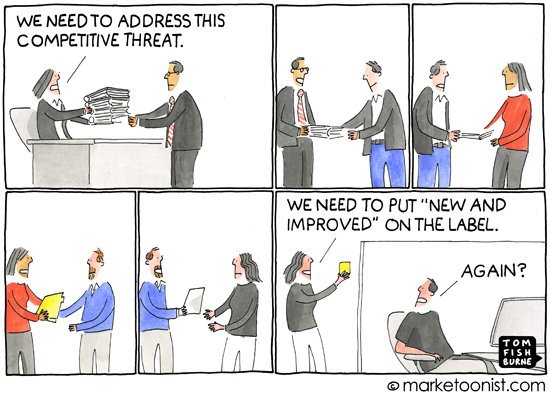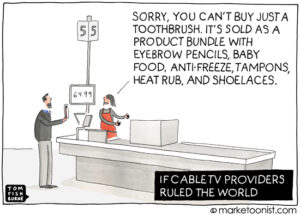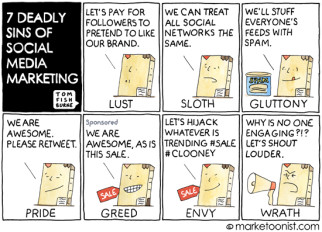If a brand has to shout that it’s “new and improved”, it’s probably not all that new or improved. “New and improved” is the easiest and lamest of marketing claims. Marketers use it to create new spin on an old brand, but it’s often not much more than label-deep. It’s the least interesting marketing lever to pull.
I was struck by this quote from HBS Professor Youngme Moon’s classic book on marketing, “Different“:
“In the 1960s and ’70s, the words “new and improved” really meant something to people; today, those same words don’t mean much at all … In category after category, it has become apparent that competitive differentiation is a myth. Or to put it more precisely, in category after category, companies have gotten so collectively locked into a particular cadence of competition that they appear to have lost sight of their mandate—which is to create meaningful grooves of separation from one another. Consequently, the harder they compete, the less differentiated they become.”
If coupons are what marketers do when they run out of meaningful marketing ideas, “new and improved” claims are what marketers do when they run out of meaningful product ideas.
Consumers know this. They know how to tune out the cacophony of me-too marketing claims. It’s easier than ever to ignore undifferentiated marketing.
One of the more bizarre trends I’ve noticed is to use “new and improved” packaging to cover up an inferior product offering. ABC News recently showcased a range of brands that distracted shoppers with “new and improved” labels from shrinking product sizes. It includes this quote: “Whenever a manufacturer says ‘new and improved’… maybe they’ve taken out some ounces.”
The most egregious example I remember of dubious “new and improved” claims was in the US yogurt category a few years ago. One of the brands downsized their product from 8 ounces to 6 ounces, but kept the same price and packaging size the same so that there was now 2 ounces of air below the lid. The “new and improved” benefit? The package now promised “room for your favorite mix-ins”. It was framed as an “improvement” to exchange yogurt for air.
More than ever, I think there’s an opportunity for marketers to think beyond new and improved. We should challenge ourselves to deliver something that is genuinely meaningfully unique.
(Marketoonist Monday: I’m giving away a signed cartoon print. Just share an insightful comment to this week’s post by 5:00 PST on Monday. Thanks!)



Ori Pomerantz says
I don’t think it is the marketers’ fault. They don’t get to specify the product specifications. It is the fault of upper management and R&D, who fail to create actual new products.
A lot of categories are essentially interchangeable commodities. Nobody wants to admit that their yogurt or toilet paper is a commodity, but it is. Asking marketers to change is asking for the impossible. You can do it, but you won’t get good results.
Tracy Carlson says
“New and improved” has been wildly abused, most recently to create a flicker of interest at the shelf where acres of me-too products line-extended into absurdity compete for the attention of weary consumers numbed into indifference. A package flag or violator becomes one reason for someone to glance at your particular package, even if the gambit is deceptive, like the disguised smaller package example you cite, Tom.
Underlying the whole “new and improved” idea are some fundamental assumptions that merit questioning these days. First, is novelty really motivating these days? When we’re drowning in stimuli and newness from everything and everyone, I don’t think so. Second, is “improvement” always necessary? In some categories, with real R & D and/or real technological change, the answer is probably yes: you’ve got to improve in order to remain competitive. But in categories most likely to use the term “new and improved,” the answer may well be no. Prior versions (before they got cost-cut, shrunk or otherwise cheapened) may very well be superior. Flagging meaningless “improvement” simply hardens our skepticism.
Nick Allen says
Just quickly.
How can something be New AND improved?
You can only improve something that isn’t new. Competing on incremental improvements is as fierce as competing in a price race to the bottom. Something significantly changing the game is the only way to cut a comfortable margin. Dare I say the cliche phrase “disrupt” an industry.
Blanca Ferrés says
To label a product with the brand attributes “new” or “improved” means you as a marketer are focusing on the product. However, if you want to attract your ideal customer, doing some market research and positioning will help in identifying what matters to your target and what else can you add as unique and key differentiator that she appreciates and would be willing to pay for.
Andrea says
As a marketing and PR practitioner one of my biggest pet peeves is when a client wants to use “new and improved”. Something cannot be new and improved!!
Tina Groves says
As a product manager, I hate being told that “there’s nothing new” in an upcoming release because the improvements don’t fit into a sound bite or aren’t worthy of a big splash. I agree with Blanca’s comments that good product starts with the basics.